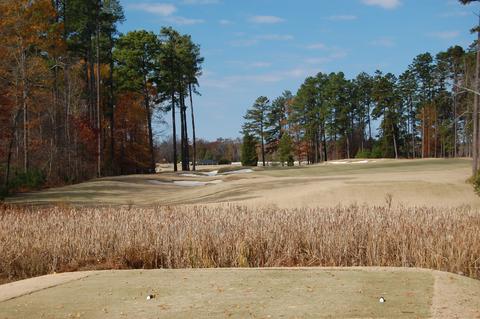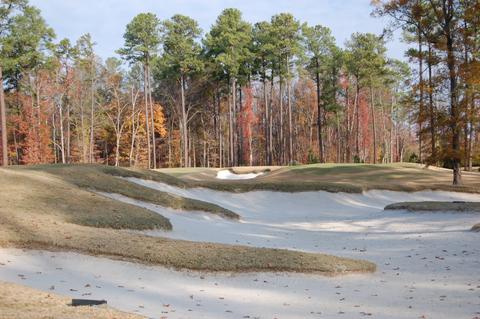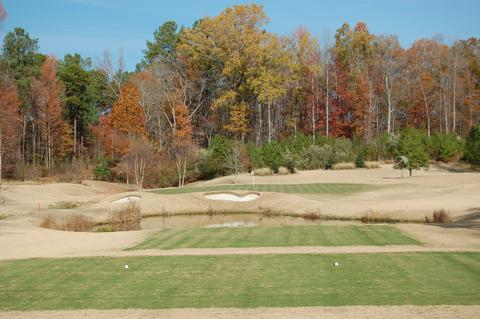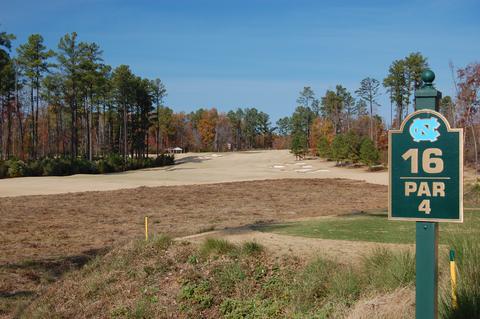
Pick your poison: Big Fazio bunkers await you on the 11th at Finley no matter which side of the fairway you choose.
Years from now, the late 20th and early 21st Centuries may be looked upon in golf circles as the Golden Age of University Golf Courses. A few years ago, the imaginatively laid out but unkempt Yale Golf Club, designed by Seth Raynor in 1926, used a multi-million dollar donation from an alumnus to return the layout to its glory days status. Duke University invited Rees Jones in 1994 to streamline the sleek and tree-lined layout his father Robert Trent originally designed in 1957. During a recent round at the private University of Texas Golf Club in Austin, it was clear to me that the club's two alumni owners had lavished lots of money on team and member practice facilities, as well as the lush and hilly course. The course is only five years old but the owners asked Tom Kite and Justin Leonard two years ago to join with original designers Bechtol-Russell to tweak the layout.
The Finley Course at the University of North Carolina is easily in the same league as Yale, Duke and UT. In 1999, Tom Fazio totally redesigned a moribund UNC track, originally opened in 1949, that was never mentioned in the same breath as the nearby Duke course. Given the intense Duke/UNC rivalry, it was only a matter of time before the proud Tarheels invested in the course.
Finley was a stunning surprise when I played it last Friday with friend and HomeOnTheCourse subscriber Bob Harris. The layout combines playability and challenges in equal measure. Fairway landing areas are rather generous, but Fazio bunkers are in abundance should your tee ball stray just a bit. Three of the four par 5s are reachable from the blue tees (6,231 yards), and what I especially liked was that none of them had those bodies of water that less-skilled designers force you to lay-up to on shortish par 5s. Fazio lets bunkers and the occasional stray tree provide the penalties for errant long approach shots.
them had those bodies of water that less-skilled designers force you to lay-up to on shortish par 5s. Fazio lets bunkers and the occasional stray tree provide the penalties for errant long approach shots.
Water did come into play on two par 3s - the 145 yard 5th and 142 yard 14th - as well as the 402 yard 9th with a pond bumping up against the right side of the green, and the 415 yard par 4 15th, where a lake guarded the entire left side from the tee to just short of the green. On the 361-yard 16th, marsh ran along the right side to 181 yards from the tee, with the fat part of the fairway just beyond. However, a bunker sat on that same line, 211 yards from the tee, forcing either a five wood tee ball or a longer drive down the much narrower left side.
The highlight of Finley, though, is the greens, which are lightning fast and mesmerizingly difficult to read. I had many putts that I scoped out from all four sides and still couldn't figure out the line. They never broke hard, but a putt that I was certain was left edge or right edge wound up breaking the opposite way more than a few times. Most of the greens were crowned, or at least had subtle false fronts, and with a majority of middle or front pin positions, shots that were short of the green required sand wedge pitches to the top of the crowns in order to stop them within a few feet the hole. A few times, Bob and I were forced to bounce chips into hills.
Conditions for late November were exquisite, and I never had even an iffy lie in the fairways. The Bermuda rough was not exceptionally deep, and being a little off line was not the penalty it will be in the dead of summer. Still, the inability to put much spin on shots from the rough made it harder to hit the fast and firm greens. Even well struck medium irons rolled more than 10 feet past their pitch marks.
If you keep the ball in play at Finley, you can score well. I was quite pleased with a 39 on the front nine, but I left myself too many long putts for par on the back nine and shot 43. Bob, who hadn't played much golf in recent months, had the right kind of putting stroke for the fast greens and made putts for four birdies, only one of them near gimmee range. When I missed a 20 footer for par on the 18th, Bob's exquisite 15-foot slider that dropped for birdie gave him a one stroke victory, and a good reason to return to Finley soon. I hope I can join him.
University of North Carolina Finley, Chapel Hill, NC, 919-962-2349, www.uncfinley.com. Tar Heel tees: 7349/7220 yards, rating 75.0, slope 141. Gold tees: 6844,72.5,134. Blue tees: 6231,69.9, 125. Red tees: 4980, 69.4, 116. Green fees for those not affiliated with the University: $47 weekdays ($18 for cart), $80 Friday thru Sunday (cart included). Click for map.

The 14th is the last par 3 on the Finley course, with water in front not really in play but a strean to the left of the small green very much so. Par from either of the small front bunkers is memorable.
























